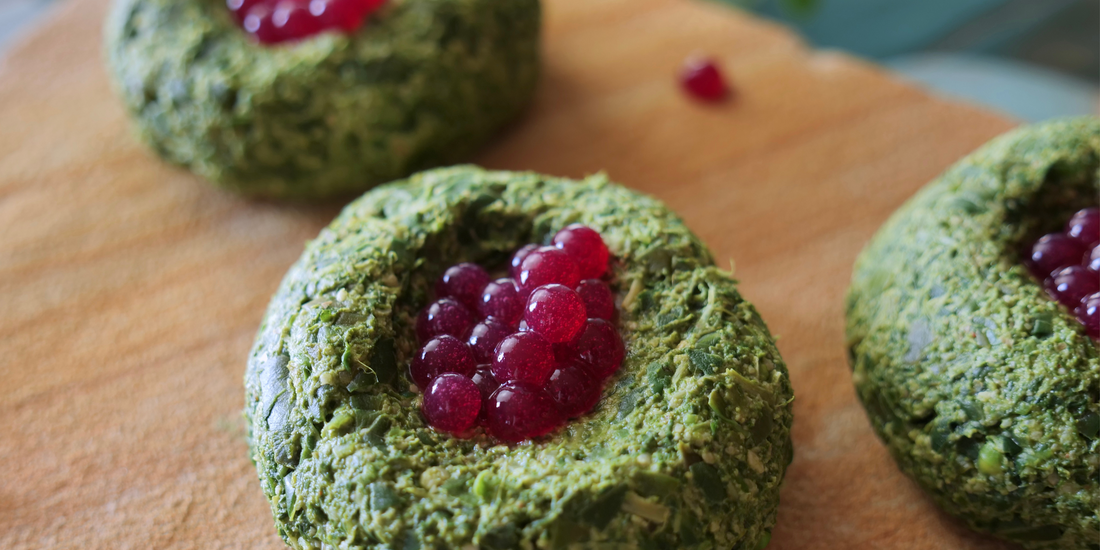
Purslane & Spinach Pkhali
Share
Pkhali is another classic Georgian dish to add to the Caucasus x Appalachia series. In this series I’ve been exploring plants that grow both here in Eastern North America and in the Republic of Georgia. How these two regions use plants in similar and dissimilar ways is the heart of this series.

At its core, Georgian pkhali is a mixture of finely minced vegetables or leafy greens married with a flavorful paste of walnuts, garlic, onion, vinegar, fresh herbs, and spices. It is often shaped into balls, appetizer-style. Think of it like a vegetable pâté. I wish I could give you an American equivalent, but nothing comes to mind. The only thing that flashes in my mind’s eye are those nut-encrusted cheese balls usually found at Christmas parties here in the American south. Beyond the ball shape and the nuts, phkali and a cheese ball don’t have much in common. Indeed, one is much more indulgent than the other. While pkhali is probably healthier than a cheese ball, I think it has just as much bite and oomph. There’s something about spreadable, dippable food that revs the taste buds. Like hiding cauliflower in your kid’s mac and cheese, pkhali is a brilliant way to get more greens into your diet.
Pkhali is not defined by a singular leafy green or vegetable. It is simply a vector in which to utilize and enjoy an array of veggies and greens. Georgians make pkhali from cultivated veggies like spinach, beetroot/beet greens, cabbage, eggplant, etc. They also make pkhali from wild greens such as nettles, amaranth, wild violet, shepherd’s purse, smilax, and purslane. In the spring when wild greens are tender, some Georgians make “field pkhali”, which combines a number of wild greens into one pkhali. There is no standard for pkhali, and as such, you could make pkhali from plants all over the world. It’s interesting that the temperate climates of North America and Georgia share much of the same flora; in this way an American cook has access to many of the same wild greens as a Georgian cook.

Purslane (Portulaca oleracea L.) - or danduri in Georgian - is one such wild plant that grows across the globe, including the Transcaucasus and North America. It’s the sort of plant that seems to love being around humans, cropping up where humans have disturbed the ground. I find it sprawling in the vegetable garden and sun bathing in the dry crevices of our gravel paths. It is a succulent annual, not too picky about where it grows. The thing I love about succulents is how juicy and plump they look. I might be crazy, but I have an urge to eat them. Purslane is edible and gives me permission to feed that craving. The raw leaf is crisp and tangy, yet more slimy than watery. Like okra, purslane has a lot of slippery mucilage. It’s a characteristic that many people might find unappetizing. I myself have had to work up to not minding and even liking that texture.
When I eat mucilaginous plants, I think about the good I am doing for my body. Plants high in mucilage counteract some of the adverse effects of our modern diets. Mucilage supplies pre-biotics and soothes irritated tissues. This helps to alleviate inflammation and restore the gut microbiome. (source) Purslane, in particular, is a powerhouse of nutrition. It is recorded to have the highest levels of alpha-linolenic acid (omega-3 fatty acid) of any terrestrial plant. It is also high in trace minerals and vitamins A and E. When compared to broccoli, purslane has 12.8 times greater vitamin A and 15.6 times greater vitamin E. (source)

I could have made a 100% purslane pkhali, but I wanted to ease into it - for your sake and my own! For this phkali variation I cut the purslane with an equal part of spinach. With all of the other ingredients at play, I didn't clock any sliminess. Spread it on a cracker with some feta or goat cheese, and I bet you won’t even notice.

Lastly, pkhali is often garnished with pomegranate arils. It’s a pop of acid to enhance the dish. I suppose it adds a bit of ornamentation as well. Anything to get people to eat their greens…Pomegranates were not in season at the time of writing this recipe - nor could I find those pre-packaged arils which would have come in handy. It turned out for the best because I got to play around with some molecular gastronomy. Direct spherification of pomegranate juice to be specific - popping pomegranate pearls as I like to think of them. What’s better than a juicy orb of pomegranate without the annoying seed? I am still learning how to make pearls (or “caviar” as the pros call it) from flavorful liquids. After 3 attempts, I was never able to prevent the pomegranate juice from gelling. So, dear reader, I’m sorry for not providing a recipe for pomegranate caviar at this time. If you are interested in learning more, check out Modernist Pantry. It is a great place to build your food chemistry tool kit and read up on techniques. One piece of advice if you do attempt pomegranate caviar: raise the pH with a splash of fresh beet juice.
Purslane & Spinach Pkhali
INGREDIENTS
- 150g purslane, cleaned and trimmed
- 150g spinach
- 75g walnuts
- Quarter of white onion or 2 spring onions
- 1 garlic clove
- 10g coriander (cilantro)
- 10g parsley
- 2 tablespoons white wine vinegar
- 1 teaspoon sea salt
- 1 teaspoon khmeli suneli* (sub. curry powder)
- ¼ teaspoon cayenne pepper
- Optional garnish: pomegranate arils or pomegranate caviar
INSTRUCTIONS
- Blanch purslane and spinach for 1 minute in a pot of boiling water. Immediately strain and run under cold water to stop the cooking process. Use a spoon to press out as much water as possible. Set aside to cool.
- Add everything else to a food processor: walnuts, onion, garlic, coriander, parsley, white wine vinegar, salt, khmeli suneli, and cayenne pepper. Blend into a smooth paste, scraping as needed.
- Squeeze any remaining moisture from the cooled purslane and spinach. Add the greens to the food processor and blend until homogenized into a paste.
- Allow the mixture to chill and firm in the fridge for at least 30 minutes.
- Form the mixture into small balls with your hands (approx. 6 balls depending on size preference). If you are garnishing with pomegranate, make a well in the tops of each ball with your finger and spoon pomegranate into the depressions.
- Serve room temp or chilled.
Notes
- Khmeli suneli is a Georgian spice blend. The blend can be quite varied, but blue fenugreek, coriander, and marigold are foundational. Use those 3 spices in equal proportions if you have them. Otherwise, substitute with curry powder.
- Enjoy pkhali on its own, spread on crackers and bread, or used as a filling.
